Balance bikes are an excellent way to introduce young children to the joys of riding. At usabikers.net, we understand the importance of finding the perfect fit for your child’s first bike, setting them up for success and a lifelong love of biking. This guide will walk you through everything you need to know, from sizing to essential features, to ensure you make the best choice. Explore the freedom of cycling and equip your child with the best ride using resources on proper gear and safety guidelines.
1. Understanding Balance Bike Sizing
What determines the right size balance bike for your child?
Wheel size and seat height are the primary factors that determine the size of a balance bike. Because toddlers and preschoolers vary greatly in height, balance bikes come in various sizes to accommodate different ages and inseams. It’s important to understand that unlike traditional bikes, balance bikes don’t have standardized sizes.
1.1. Wheel Size vs. Seat Height: Which Matters Most?
Balance bike sizes can vary significantly. Although online listings often mention the wheel size (e.g., 12″ or 14″), it isn’t always a reliable indicator of the bike’s overall size. Two bikes with the same wheel size can be designed to fit children of vastly different ages.
Seat height range is the most important factor in determining the true size of a balance bike. To select the proper size, first measure your child’s inseam, then match it to the bike’s seat height range.
1.2. How to Measure Your Child’s Inseam
How do you accurately measure your child’s inseam for a balance bike?
The “book and wall” method is an effective way to measure your child’s inseam. Have your child stand with shoes on against a wall, place a book between their legs, and gently raise it until it meets their crotch. Ensure the book is level with the floor, then measure the distance from the top of the book to the ground. This measurement is key to finding the right balance bike size.
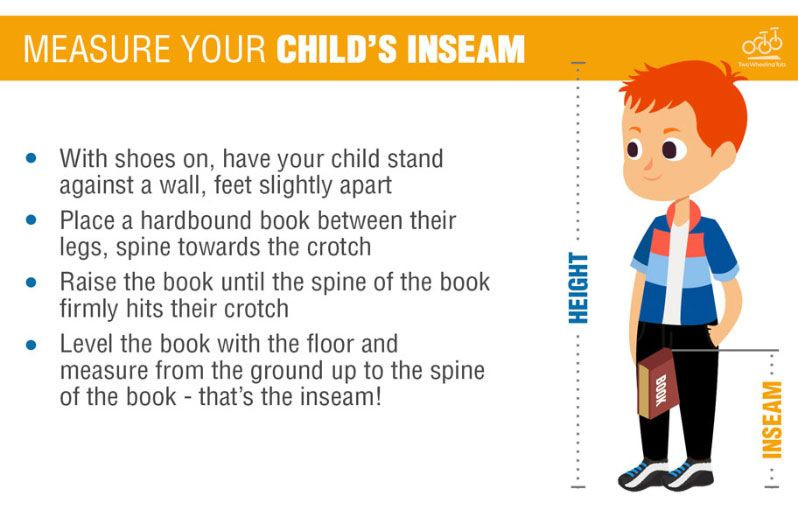 Infographic on how to measure your child
Infographic on how to measure your child
1.3. Finding the Right Seat Height
What is the ideal seat height for a balance bike to ensure comfort and control?
The ideal seat height allows your child to place their feet flat on the ground with a slight bend in their knees. This position enables them to comfortably sit on the saddle while walking, running, and gliding.
This means the balance bike seat should be set about 0.5″ to 1″ less than the child’s inseam. If your child’s inseam is 13″, you should look for a bike with a minimum seat height no taller than 12.5″.
To allow room for growth, ensure the bike’s maximum seat height is at least 2″ above the child’s current inseam. For a child with a 13″ inseam, a bike with a maximum seat height of at least 15″ is ideal.
Example Child Inseam vs. Desired Seat Height Range
| Child’s Inseam | Desired Min. Seat Height (-0.5″) | Desired Max. Seat Height (+2″) |
|---|---|---|
| 11.5″ | no taller than 11″ | at least 13.5″ |
| 13.5″ | no taller than 13″ | at least 15.5″ |
| 17″ | no taller than 16.5″ | at least 19″ |
1.4. Why Seat Position Matters
Why is the seat position so important for a balance bike?
The seat position is crucial for comfort, efficiency, and safety. A seat that’s too low can make running and gliding less natural, while a seat that’s too high makes it difficult to gain momentum and stop safely. The optimal knee bend can be achieved by setting the seat about 0.5″ to 1″ below the child’s inseam.
2. Key Features to Consider When Buying a Balance Bike
Besides size, what other features should you consider when buying a balance bike?
Several key features can significantly impact a child’s experience with a balance bike:
- Weight
- Geometry
- Tire Type
- Brakes
- Turning Limiters
- Footrests
- Bearings
- Frame Materials
- Hand Grips
- Bolts
2.1. Weight: Finding the Right Balance
How important is the weight of a balance bike?
The weight of a balance bike is very important for young riders. As a general rule, the bike should not weigh more than 30% of your child’s weight. A lighter bike is easier for a child to maneuver and control. The frame and wheels greatly affect a bike’s overall weight.
| Weight of a Bike vs. Child |
|---|
| A 10-pound bike can be difficult for a 25 lb. 2-year-old to maneuver, but much easier for a 35 lb. 3.5-year-old. |
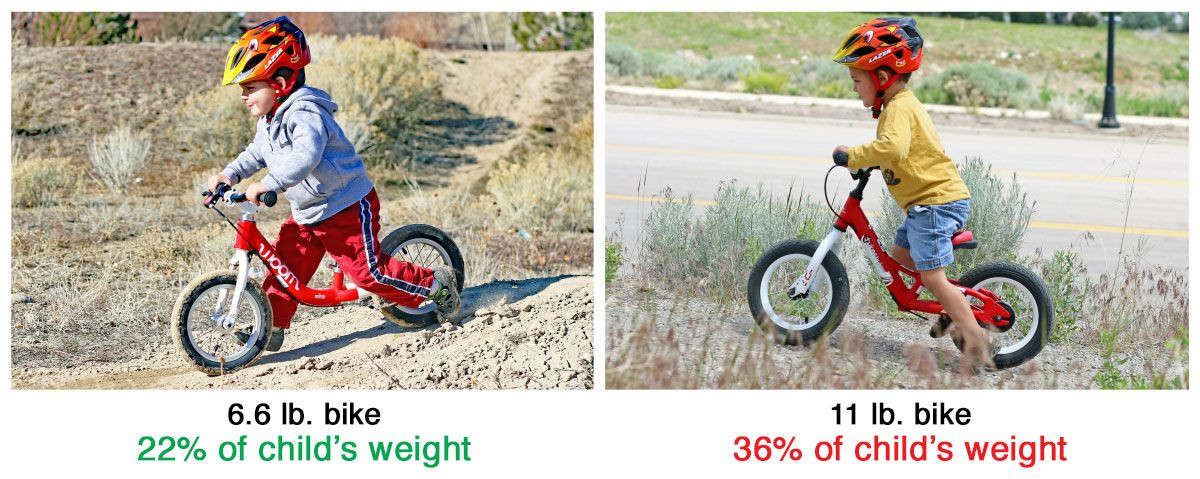 Child riding two balance bikes. One is only 6.6 lbs and is 22% of his weight. The other is 11 lbs and is 36% of his weight
Child riding two balance bikes. One is only 6.6 lbs and is 22% of his weight. The other is 11 lbs and is 36% of his weight
2.2. Foam Tires vs. Air Tires: Which is Better?
What are the differences between foam and air tires on a balance bike?
Tires play a vital role in a bike’s performance and comfort. The two main types are foam and air tires. Foam tires are common on balance bikes because they are inexpensive, lightweight, and puncture-proof. They are suitable for neighborhood riders who stick to pavement.
Air tires provide superior traction and cushioning compared to foam tires. Air tires flex when compressed, reducing the impact felt by the child. They also offer better traction, especially on all-terrain surfaces.
| Feature | Foam Tires | Air Tires |
|---|---|---|
| Puncture Proof | ✔️ | |
| Cushions Impact | ✔️ | |
| Superior Traction | ✔️ | |
| Easily Replaceable | ✔️ | |
| All-terrain | ✔️ |
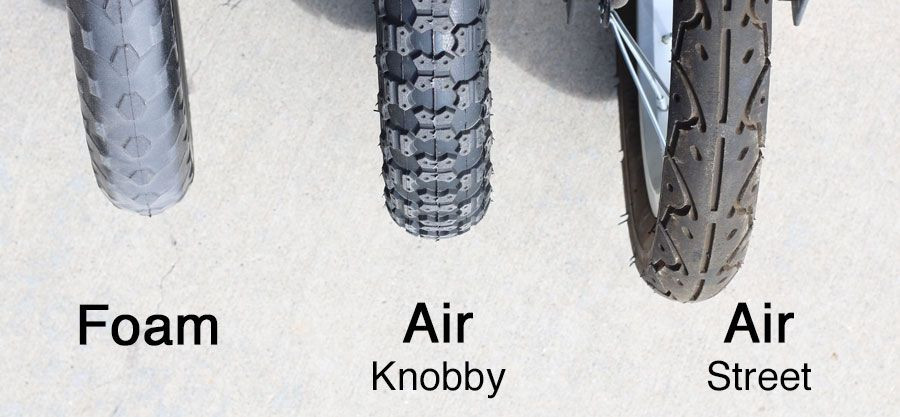 Three balance bike tires lined up next to each other – foam, knobby air, and street tread air.
Three balance bike tires lined up next to each other – foam, knobby air, and street tread air.
2.3. Brakes: Do Balance Bikes Need Them?
Do balance bikes need brakes, and what type is best?
While kids primarily use their feet to stop a balance bike, hand brakes are a valuable addition. They can help prevent injuries, save shoes, and prepare children for pedal bikes.
Most preschoolers have enough hand-eye coordination to use a hand brake, typically between 2.5 and 3.5 years old. Higher-end bikes, such as the woom 1, have short-reach brakes that are easier for small hands to use.
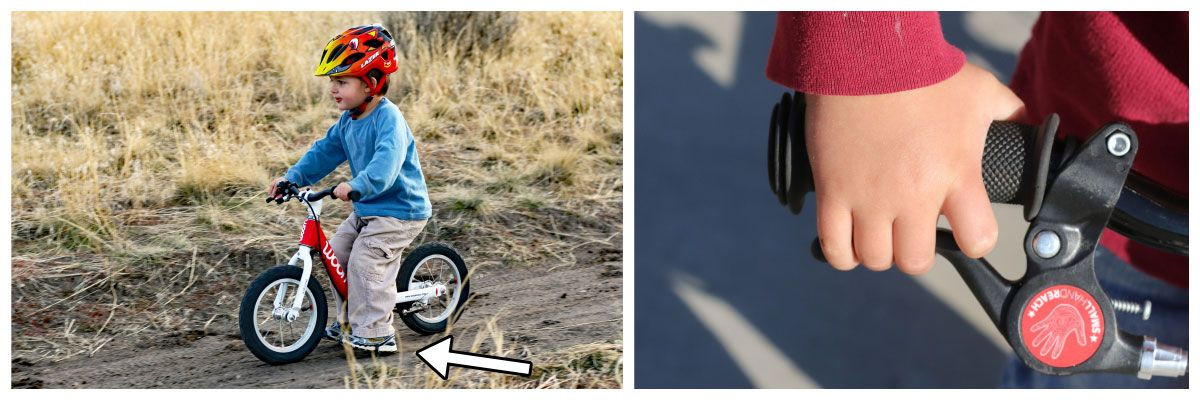 A child stopping a balance bike using his feet and then using a hand brake
A child stopping a balance bike using his feet and then using a hand brake
2.4. Geometry: How It Affects Performance
What role does geometry play in a balance bike’s performance?
The geometry of a balance bike significantly affects its performance. Good geometry helps a child balance and maneuver, while poor geometry can hinder their progress.
Key elements of good geometry include frame design, wheelbase, handlebar shape and size, seat position relative to the tires, and the angle of the front fork.
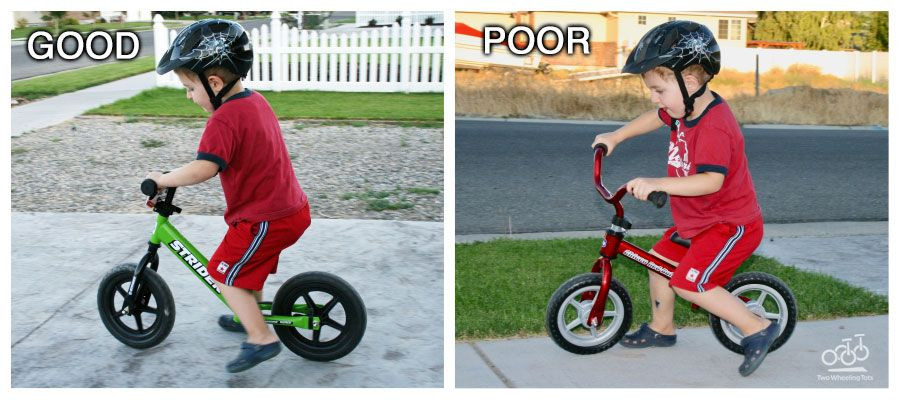 Side by side examples of a child on a good and bad balance bike: Strider (good), Chicco Red Bullet (bad)
Side by side examples of a child on a good and bad balance bike: Strider (good), Chicco Red Bullet (bad)
2.5. Turning Limiters: Pros and Cons
What are turning limiters and are they necessary?
Turning limiters prevent the handlebar and front wheel from completing a full revolution. They are designed to prevent sharp turns and protect the brake cable. While some argue they prevent jackknifing, others believe they hinder proper steering development.
The overall effect of most limiters on riding is minor, and their presence shouldn’t be a determining factor in your purchase.
2.6. Footrests: Helpful or Hindrance?
Are footrests necessary on a balance bike?
Most balance bikes don’t have footrests, as they are not essential. When gliding, children instinctively hold their feet up. Some argue that footrests can be a crutch, causing children to focus more on their feet than on balancing and steering. Poorly designed footrests can interfere with a child’s stride. A properly designed footrest is tucked back under the seat and out of the way.
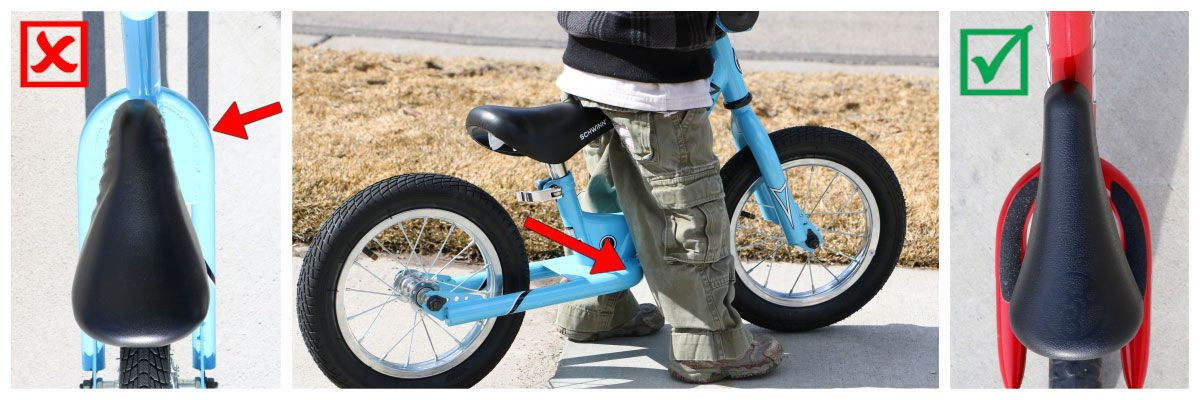 balance bike footrests design. Good and bad examples.
balance bike footrests design. Good and bad examples.
2.7. Wheel Bearings: Smoothness and Efficiency
How do wheel bearings affect a balance bike’s performance?
The bearings of a bike determine how smoothly and quickly the tires spin. Sealed bearings prevent water, dirt, and dust from entering, reducing friction and providing a smoother ride with less effort. Sealed bearings are a “nice-to-have” feature that enhances the overall riding experience.
2.8. Frame Materials: Metal, Wood, or Composite?
What are the pros and cons of different frame materials?
Balance bike frames are typically made from aluminum, steel, wood, or composite materials. Metal frames, especially aluminum alloy 6061, are lightweight, strong, and rust-proof. Steel frames are common on less expensive models but are heavier and prone to rust.
Wood bikes can be more environmentally friendly but are less adjustable than metal bikes. Composite frames offer a lightweight option with a high weight capacity.
2.9. Hand Grips: Safety and Comfort
Why are handlebar grips important on a balance bike?
Handlebar grips are essential for safety. Rubber grips with a knobby end protect children’s hands from impacts with walls, trees, or the ground during falls. Protective bumpers are an easy and common way to keep your child safe.
 woom 1 balance bike grips
woom 1 balance bike grips
2.10. Axle Bolts: Preventing Scratches
Why does the type of axle bolts matter?
The style of axle bolts can impact safety and comfort. Larger bolts that protrude from the bike can scratch little legs. Higher-end bikes have flat or low-profile bolts recessed in the fork to prevent contact.
3. Intent of User Search
Here are five user search intentions related to the keyword “How To Buy A Balance Bike”:
- Finding the right size: Users want to know how to properly size a balance bike for their child to ensure comfort and safety.
- Understanding key features: Users want to learn about the important features of a balance bike, such as tire type, brakes, and frame material, to make an informed decision.
- Comparing different brands and models: Users are looking for recommendations and comparisons of various balance bike brands and models to find the best option for their needs.
- Learning about the benefits of balance bikes: Users want to understand the advantages of balance bikes over traditional training wheels to ensure they are making the right choice for their child’s development.
- Finding affordable options: Users are searching for budget-friendly balance bike options that still offer quality and safety.
4. usabikers.net: Your Go-To Resource for All Things Biking
At usabikers.net, we provide comprehensive information and resources for all biking enthusiasts. Whether you’re a parent looking to get your child started with a balance bike or a seasoned biker seeking the latest gear and tips, we’ve got you covered.
Challenges and Solutions:
- Challenge: Lack of reliable information about balance bike models and features.
- Solution: usabikers.net provides detailed reviews and comparisons of various balance bikes.
- Challenge: Difficulty finding the right size balance bike for your child.
- Solution: Our comprehensive sizing guide helps you accurately measure your child and select the appropriate bike.
- Challenge: Confusion about the benefits of balance bikes over traditional training wheels.
- Solution: We offer articles and guides that explain the advantages of balance bikes in developing balance and coordination.
Call to Action:
Visit usabikers.net today to explore our articles, reviews, and community forums. Find the perfect balance bike for your child and join a community of biking enthusiasts who share your passion.
5. Frequently Asked Questions (FAQ)
Here are 10 frequently asked questions about buying a balance bike:
- What is a balance bike?
- A balance bike is a two-wheeled bike without pedals, designed to teach children balance and coordination.
- What age is appropriate for a balance bike?
- Balance bikes are typically suitable for children aged 18 months to 5 years.
- How do I choose the right size balance bike?
- Measure your child’s inseam and ensure the bike’s seat height is adjustable to that measurement, allowing for a slight bend in the knees.
- Are balance bikes better than training wheels?
- Yes, balance bikes are generally considered better as they teach children to balance naturally, making the transition to a pedal bike easier.
- What are the key features to look for in a balance bike?
- Look for lightweight frames, adjustable seat heights, appropriate tire types, and hand brakes for added safety.
- Should I choose foam or air tires for a balance bike?
- Air tires provide better cushioning and traction, but foam tires are puncture-proof and require less maintenance.
- Do balance bikes need brakes?
- Hand brakes are a good addition, helping children learn to stop safely and preparing them for pedal bikes.
- What is the best frame material for a balance bike?
- Aluminum frames are lightweight and rust-resistant, making them a popular choice.
- Are footrests necessary on a balance bike?
- Footrests are not essential, as children instinctively hold their feet up when gliding.
- How much should I spend on a balance bike?
- Balance bike prices vary widely, but investing in a quality bike with adjustable features and durable materials is recommended.
6. Embracing the Biker Lifestyle
usabikers.net is more than just a website; it’s a community where biking enthusiasts come together to share their passion. We understand the thrill of the ride, the freedom of the open road, and the camaraderie of fellow bikers.
6.1. Connecting with the Community
What benefits does usabikers.net offer to the biking community?
usabikers.net offers a platform to connect with like-minded individuals, share experiences, and discover new adventures:
- Forums: Engage in discussions about bike maintenance, riding techniques, and the latest trends.
- Events: Stay informed about local and national biking events, rallies, and meetups.
- Gear Reviews: Get honest and unbiased reviews of the latest biking gear and accessories.
- Riding Tips: Improve your skills with expert advice and tutorials on riding safely and efficiently.
6.2. Staying Informed and Inspired
How does usabikers.net keep bikers up-to-date and motivated?
usabikers.net provides a constant stream of information and inspiration to keep bikers engaged:
- Latest News: Stay informed about industry news, regulatory changes, and technological advancements.
- Inspirational Stories: Read about the adventures of fellow bikers and their inspiring journeys.
- Maintenance Tips: Learn how to keep your bike in top condition with our detailed maintenance guides.
- Customization Ideas: Discover creative ways to personalize your bike and make it your own.
7. Essential Considerations for Motorcycle Safety
Prioritizing safety is paramount for all motorcycle riders. Understanding potential hazards and implementing safe riding practices are crucial for preventing accidents and ensuring a secure journey.
7.1. Fundamental Safety Gear for Bikers
What essential protective equipment should every biker wear?
Wearing the appropriate safety gear significantly reduces the risk of injuries in the event of a crash:
- Helmets: A high-quality helmet that meets DOT standards is crucial for head protection.
- Jackets: Protective jackets made from leather or reinforced synthetic materials offer abrasion resistance and impact protection.
- Gloves: Gloves provide hand protection and improve grip control.
- Boots: Sturdy boots offer ankle and foot protection.
- Pants: Reinforced pants protect the legs from abrasions and impacts.
7.2. Mastering Safe Riding Techniques
What essential skills should bikers master for a safer riding experience?
Developing and practicing safe riding techniques is essential for avoiding accidents:
- Defensive Riding: Anticipate potential hazards and react accordingly.
- Braking Skills: Practice emergency braking techniques to maintain control.
- Cornering Techniques: Master proper cornering techniques for smooth and safe turns.
- Visibility: Enhance visibility by wearing bright clothing and using reflective gear.
- Road Awareness: Stay attentive to road conditions, traffic, and potential obstacles.
7.3. Routine Motorcycle Maintenance and Inspection
Why are regular maintenance and inspections crucial for motorcycle safety?
Regular maintenance and thorough inspections are crucial for maintaining your motorcycle’s optimal performance and preventing mechanical failures:
- Tire Condition: Regularly check tire pressure and tread depth.
- Brake System: Inspect brake pads, rotors, and fluid levels.
- Fluid Levels: Monitor engine oil, coolant, and brake fluid levels.
- Lights and Signals: Ensure all lights and signals are functioning properly.
- Chain/Belt Maintenance: Keep the chain or belt properly lubricated and adjusted.
7.4. Understanding Traffic Regulations and Road Laws
Why is it essential for bikers to adhere to traffic regulations and road laws?
Adhering to traffic regulations and road laws ensures your safety and the safety of other road users:
- Speed Limits: Obey posted speed limits and adjust your speed according to road conditions.
- Lane Discipline: Maintain proper lane positioning and avoid weaving through traffic.
- Signal Usage: Use signals to indicate your intentions to other drivers.
- Traffic Signals: Obey traffic signals and signs.
- Impaired Riding: Never ride under the influence of alcohol or drugs.
8. Balance Bike Models and Brand Recommendations
Selecting the right balance bike model and brand can significantly impact your child’s learning experience and overall enjoyment. At usabikers.net, we have thoroughly researched and assessed the top balance bikes available to offer you the best recommendations.
8.1. Highlighted Models and Key Features
Can you recommend the top balance bike models and their essential features?
The following balance bike models have consistently received high praise from parents and experts:
- woom 1: Renowned for its ultra-lightweight design, excellent ergonomics, and responsive hand brakes.
- Strider Sport: A versatile and durable option with adjustable seat and handlebar heights, making it suitable for a wide age range.
- Guardian Balance Bike: Recognized for its robust construction, comfortable seating, and user-friendly design.
- Ridgeback Scoot: Appreciated for its stable geometry, smooth ride, and stylish aesthetics.
- Strider 14x: Noted for its unique design, which allows it to be easily converted into a pedal bike, providing a seamless transition for your child.
8.2. Detailed Comparison of Top Brands
What are the key differences between leading balance bike brands?
The top balance bike brands offer distinct advantages:
- woom: Focuses on creating lightweight, high-performance bikes with exceptional attention to detail and child-specific ergonomics.
- Strider: Known for its durable and affordable bikes designed to accommodate a wide range of ages and skill levels.
- Guardian: Emphasizes safety and comfort, with bikes featuring robust construction and user-friendly designs.
- Ridgeback: Offers stylish and well-designed bikes with a focus on stability and smooth riding experiences.
| Brand | Key Features | Strengths |
|---|---|---|
| woom | Lightweight, Ergonomic Design, Responsive Brakes | High Performance, Exceptional Comfort |
| Strider | Durable, Affordable, Adjustable | Versatile, Wide Age Range |
| Guardian | Robust Construction, Comfortable Seating, User-Friendly Design | Safety, Ease of Use |
| Ridgeback | Stable Geometry, Smooth Ride, Stylish Aesthetics | Stability, Smoothness |
8.3. Ratings and Reviews from the usabikers.net Community
What are the ratings and reviews of these models from the usabikers.net community?
The usabikers.net community provides valuable insights and ratings for balance bike models:
- woom 1: Consistently receives high ratings for its lightweight design and exceptional build quality.
- Strider Sport: Highly praised for its durability and adaptability, making it a popular choice among parents.
- Guardian Balance Bike: Appreciated for its safety features and ease of use, making it a great option for beginners.
- Ridgeback Scoot: Praised for its stylish design and smooth riding experience.
8.4. Special Deals and Offers
Are there any special deals or offers available for balance bikes on usabikers.net?
usabikers.net regularly features special deals and offers on a wide range of balance bikes:
- Seasonal Promotions: Take advantage of discounts and promotions during holidays and seasonal events.
- Exclusive Offers: Access exclusive deals available only to usabikers.net community members.
- Bundle Deals: Save money by purchasing balance bike bundles that include essential accessories.
9. Expert Tips for Teaching Your Child to Ride a Balance Bike
Teaching your child to ride a balance bike can be a rewarding experience. The team at usabikers.net has gathered expert tips to help you guide your child through the learning process effectively.
9.1. Starting with the Basics
What are the initial steps for introducing your child to a balance bike?
Begin by creating a positive and encouraging environment for your child:
- Familiarization: Allow your child to get comfortable with the bike by walking alongside it and pushing it around.
- Proper Fit: Ensure the seat height is adjusted correctly so that your child can comfortably place their feet flat on the ground with a slight bend in their knees.
- Safe Environment: Choose a safe, flat surface, such as a park or driveway, for your child to practice on.
9.2. Encouraging the Gliding Motion
How can you encourage your child to transition from walking to gliding?
Encourage your child to lift their feet and glide once they feel comfortable walking with the bike:
- Demonstration: Show your child how to lift their feet and glide by demonstrating the motion yourself.
- Positive Reinforcement: Offer praise and encouragement when your child attempts to glide.
- Game-Based Learning: Turn the process into a game by creating challenges or obstacle courses that encourage gliding.
9.3. Teaching Steering and Balance
What techniques can help children learn to steer and maintain balance?
Once your child is comfortable gliding, focus on teaching them steering and balance:
- Leaning Technique: Explain and demonstrate how leaning their body helps them steer the bike.
- Eye Focus: Encourage your child to look ahead in the direction they want to go.
- Practice: Provide opportunities for your child to practice steering and balancing in a safe and controlled environment.
9.4. Providing Support and Encouragement
What role does parental support play in the learning process?
Parental support and encouragement are essential for your child’s success:
- Patience: Be patient and understanding as your child learns at their own pace.
- Positive Attitude: Maintain a positive and encouraging attitude, even when your child encounters challenges.
- Celebrate Success: Celebrate your child’s achievements, no matter how small, to build their confidence.
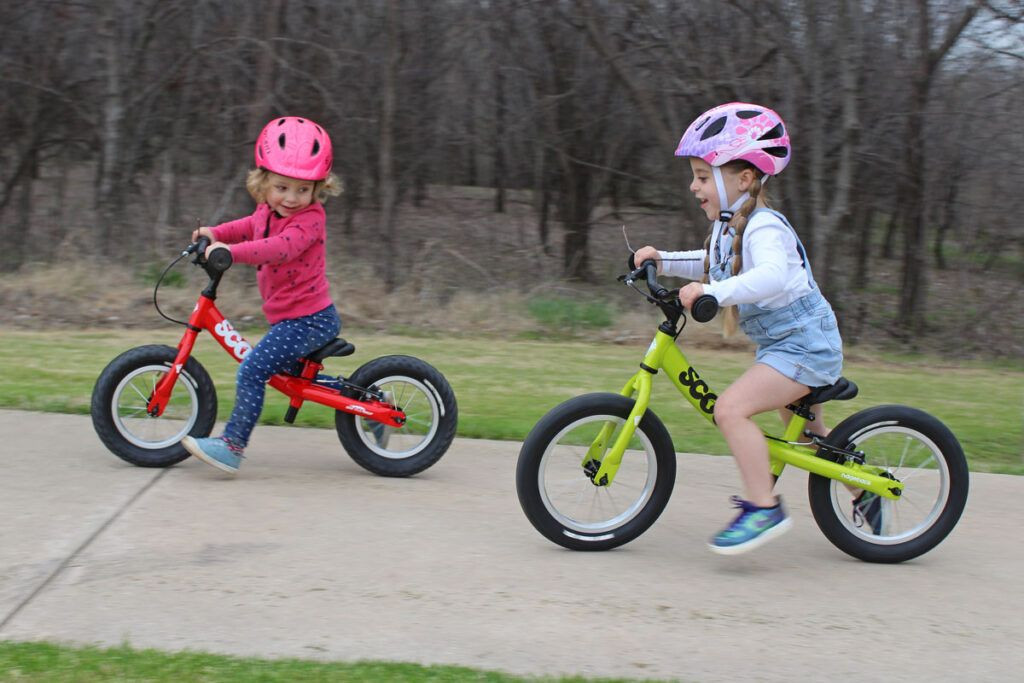 Two girls on balance bikes racing each other. A 2 year old is on the Ridgeback Scoot. The 4 year old is on the Ridgeback Scoot XL.
Two girls on balance bikes racing each other. A 2 year old is on the Ridgeback Scoot. The 4 year old is on the Ridgeback Scoot XL.
10. Joining the usabikers.net Community
usabikers.net is committed to fostering a vibrant community for biking enthusiasts.
10.1. Exploring Community Forums
What topics are discussed in the community forums on usabikers.net?
The community forums on usabikers.net cover a wide array of topics, including:
- Bike Maintenance: Share tips and advice on how to keep your bike in top condition.
- Riding Tips: Discuss and exchange riding techniques for various terrains and conditions.
- Gear Recommendations: Get recommendations and reviews on the latest biking gear and accessories.
- Event Discussions: Discuss and plan local and national biking events and meetups.
10.2. Sharing Experiences and Tips
How can community members share their experiences and tips on usabikers.net?
usabikers.net provides several avenues for community members to share their experiences and tips:
- Forum Posts: Create and participate in forum discussions to share your knowledge and insights.
- Blog Contributions: Submit blog posts to share your biking experiences, tips, and stories.
- Gear Reviews: Write reviews of your favorite biking gear and accessories to help other members make informed decisions.
10.3. Participating in Events and Meetups
How can community members participate in events and meetups organized by usabikers.net?
usabikers.net organizes and promotes a variety of events and meetups for community members:
- Local Rides: Join local group rides to explore scenic routes and connect with fellow bikers.
- Workshops: Attend workshops to learn new skills and techniques related to bike maintenance and riding.
- Rallies: Participate in regional and national biking rallies to connect with a broader community of enthusiasts.
10.4. Staying Connected on Social Media
How can community members stay connected with usabikers.net on social media?
usabikers.net maintains a strong presence on social media platforms to keep community members informed and engaged:
- Facebook: Join the usabikers.net Facebook group to receive updates, share content, and connect with other members.
- Instagram: Follow usabikers.net on Instagram for inspiring photos, videos, and stories from the biking world.
- Twitter: Follow usabikers.net on Twitter for quick updates, news, and announcements.
Address: 801 Sturgis Main St, Sturgis, SD 57785, United States.
Phone: +1 (605) 347-2000.
Website: usabikers.net.
